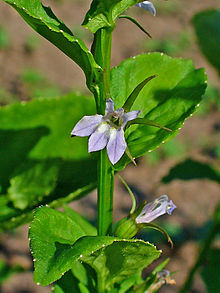Indian tobacco
| Indian tobacco | ||||||||||||
|---|---|---|---|---|---|---|---|---|---|---|---|---|

Indian tobacco ( Lobelia inflata ) |
||||||||||||
| Systematics | ||||||||||||
|
||||||||||||
| Scientific name | ||||||||||||
| Lobelia inflata | ||||||||||||
| L. |
Indian tobacco , also called puffed lobelia ( Lobelia inflata ), is a type of plant from the bellflower family (Campanulaceae). Despite its common German name , this poisonous plant species has nothing to do with the tobacco genus from the nightshade family (Solanaceae) in botanical terms.
features
The Indian tobacco is an annual plant that reaches a height of up to 1 meter. The stem is branched and hairy. The alternate arranged on the stem leaves are stalked sitting or short. The leaf blade is ovate-oval with a serrated edge.
The terminal, racemose inflorescences contain many flowers. The hermaphrodite flower is zygomorphic . The blue or white petals are 6 to 8 millimeters long. The corolla is two-lipped, with an upper lip consisting of two protruding lobes and a three-lobed lower lip that is hairy on the inside. When the fruit is ripe, the flower cup is inflated.
Occurrence
The distribution area of Indian tobacco extends over the east coast of North America and the area of the Great Lakes . He prefers open forests as a location.
use
Use as an ornamental plant
The Indian tobacco is grown as an ornamental plant in parks and gardens.
Ingredients and Medical Uses
Dried Indian tobacco contains around 6% various alkaloids , including the main alkaloid lobeline , which is found in the roots, stems and leaves. Taken parenterally , it shows a stimulating effect on breathing. In the past, the drug and its preparations were used as an anti-asthmatic. Since lobeline has similar properties to nicotine , but unpleasant side effects such as B. nausea, it is often a component of smoking cessation drugs. After ingestion, lobeline is quickly broken down into ineffective compounds, so that poisoning is hardly to be expected.
The Indian tobacco was used in the traditional medicine of various Indian tribes . The root was used to treat venereal diseases and ulcers, the ground leaves against various skin diseases and as an antidote to alleged witchcraft. The leaves were also smoked in religious ceremonies.
swell
- United States Department of Agriculture Plant Guide . (PDF file; 62 kB)
- Indian tobacco in the Canadian Poisonous Plants Information System .
Individual evidence
- ↑ Erlangen Botanical Garden of the University of Erlangen - Nuremberg: Medicinal Plants , page 68f.
